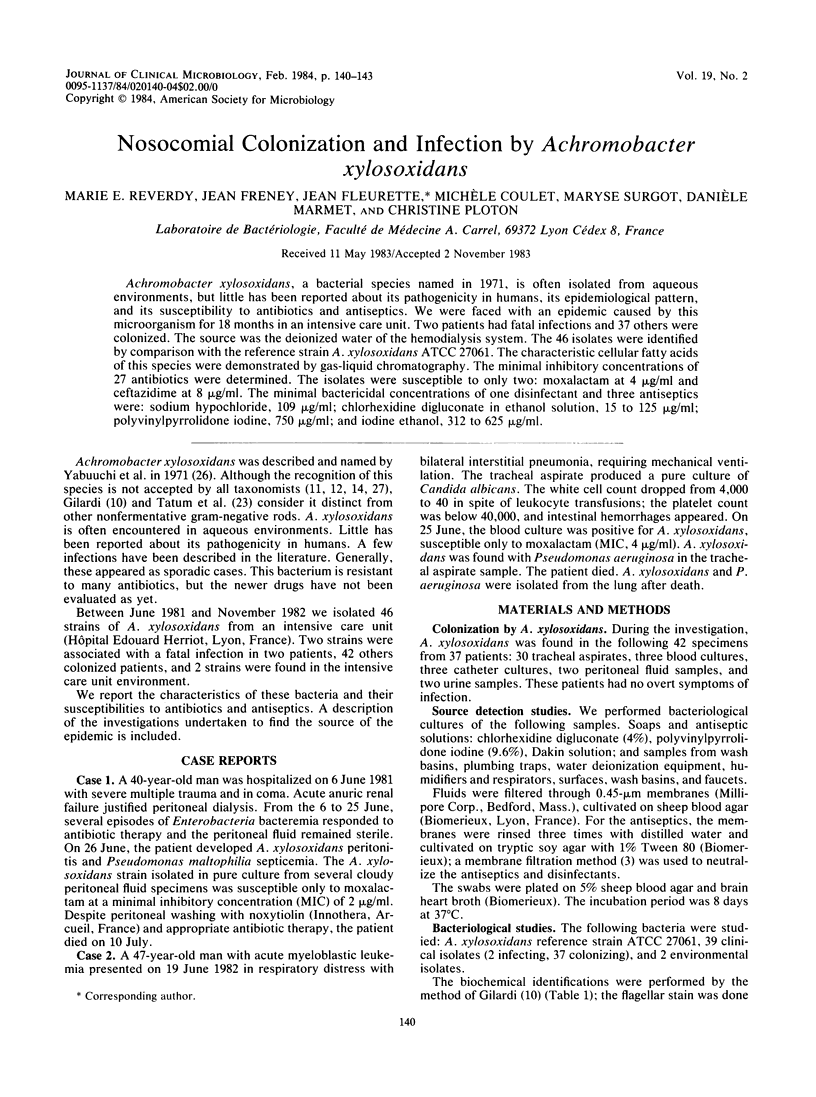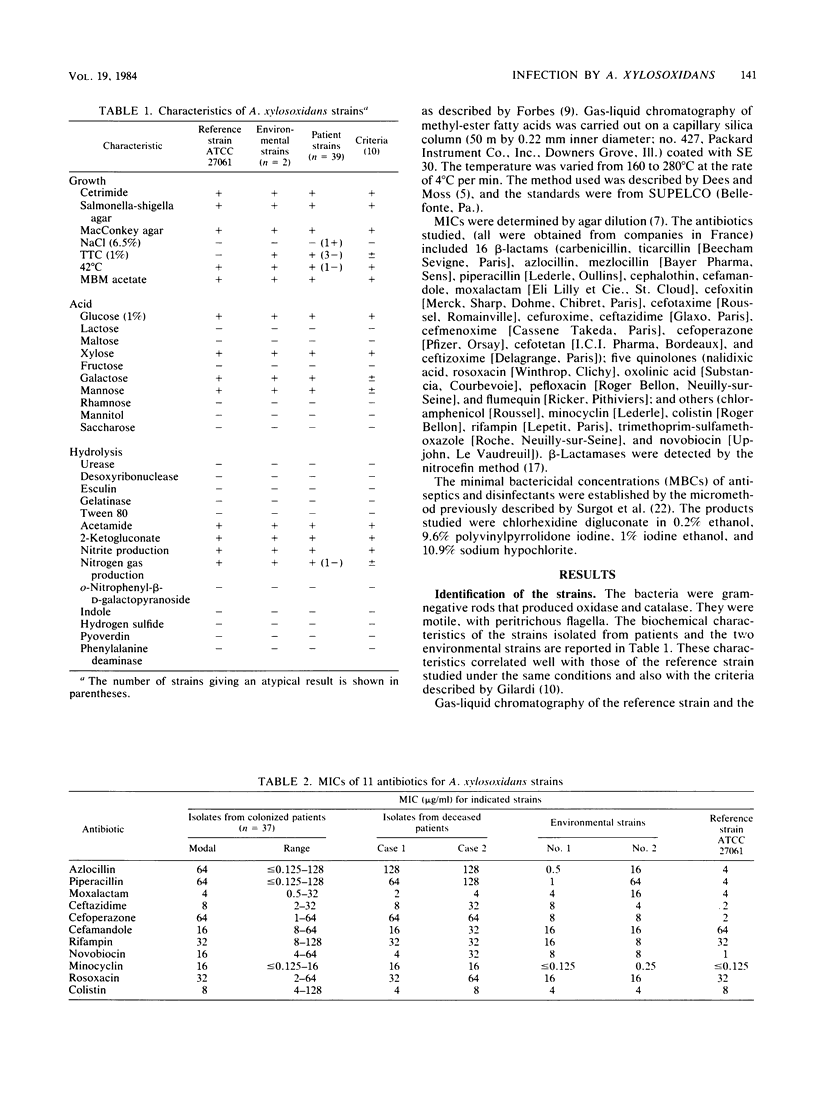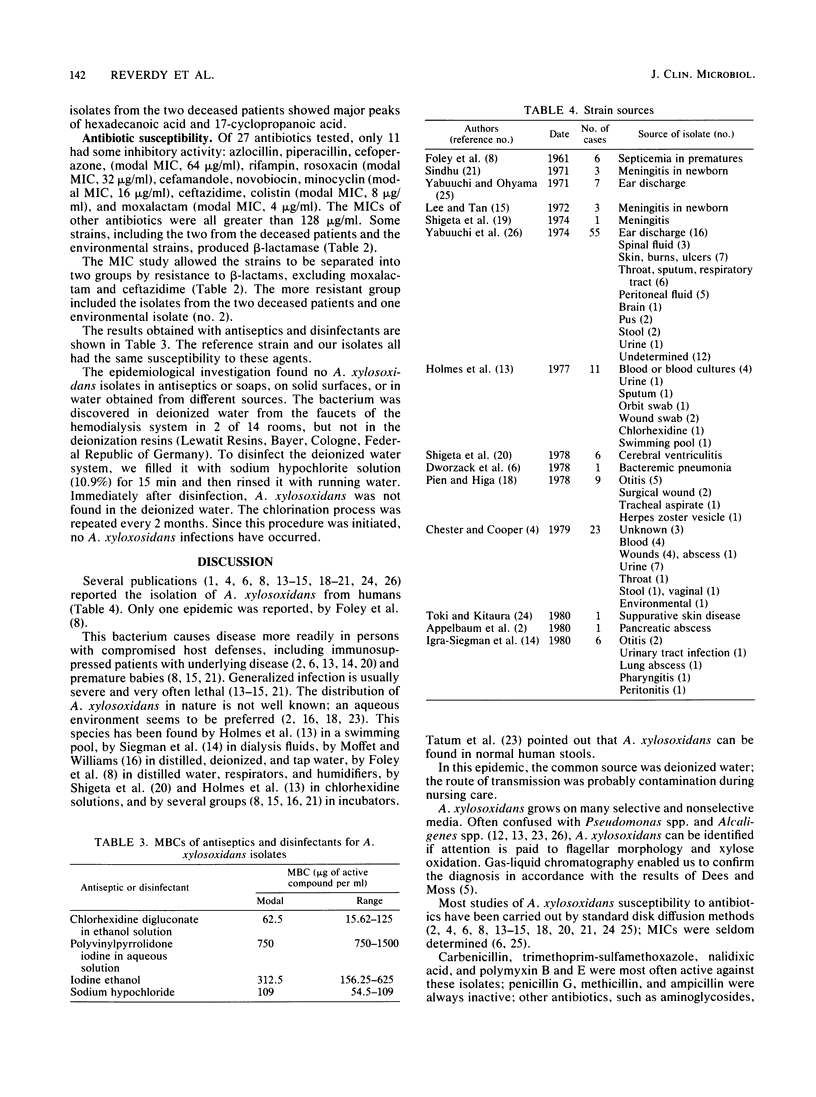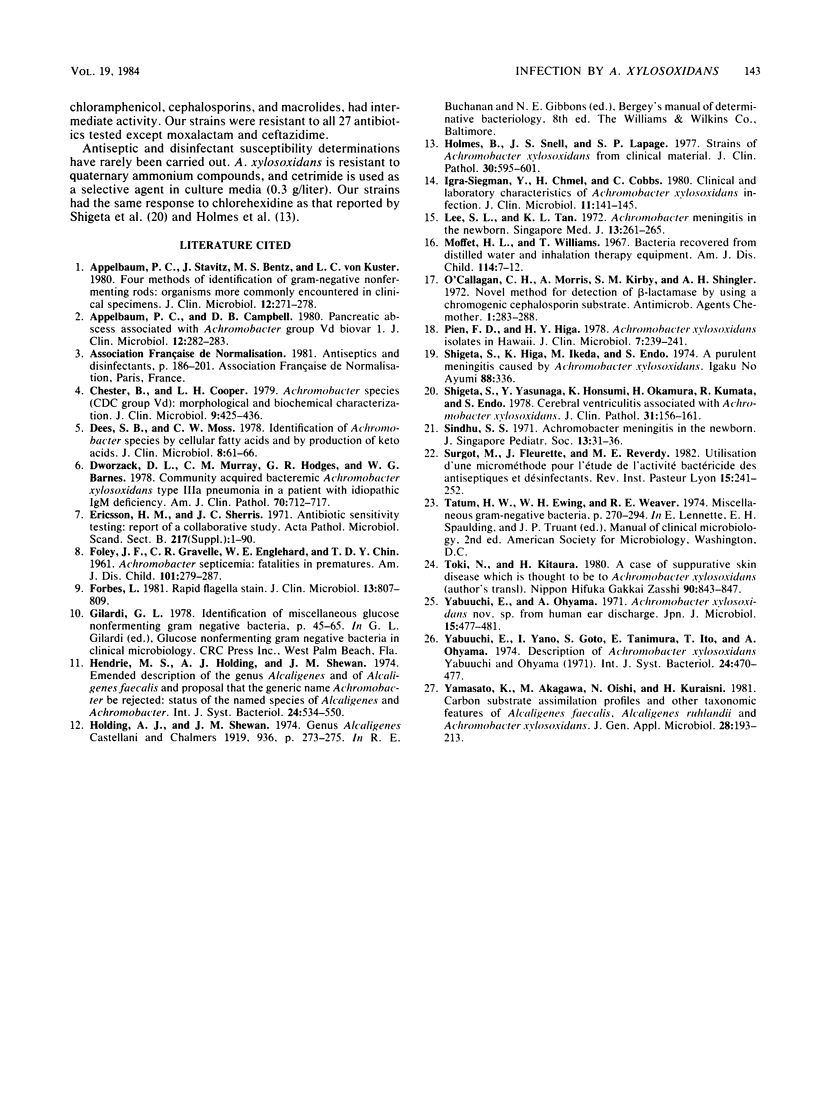Abstract
Achromobacter xylosoxidans, a bacterial species named in 1971, is often isolated from aqueous environments, but little has been reported about its pathogenicity in humans, its epidemiological pattern, and its susceptibility to antibiotics and antiseptics. We were faced with an epidemic caused by this microorganism for 18 months in an intensive care unit. Two patients had fatal infections and 37 others were colonized. The source was the deionized water of the hemodialysis system. The 46 isolates were identified by comparison with the reference strain A. xylosoxidans ATCC 27061. The characteristic cellular fatty acids of this species were demonstrated by gas-liquid chromatography. The minimal inhibitory concentrations of 27 antibiotics were determined. The isolates were susceptible to only two: moxalactam at 4 micrograms/ml and ceftazidime at 8 micrograms/ml. The minimal bactericidal concentrations of one disinfectant and three antiseptics were: sodium hypochloride, 109 micrograms/ml; chlorhexidine digluconate in ethanol solution, 15 to 125 micrograms/ml; polyvinylpyrrolidone iodine, 750 micrograms/ml; and iodine ethanol, 312 to 625 micrograms/ml.
Full text
PDF



Selected References
These references are in PubMed. This may not be the complete list of references from this article.
- Appelbaum P. C., Campbell D. B. Pancreatic abscess associated with Achromobacter group Vd biovar 1. J Clin Microbiol. 1980 Aug;12(2):282–283. doi: 10.1128/jcm.12.2.282-283.1980. [DOI] [PMC free article] [PubMed] [Google Scholar]
- Appelbaum P. C., Stavitz J., Bentz M. S., von Kuster L. C. Four methods for identification of gram-negative nonfermenting rods: organisms more commonly encountered in clinical specimens. J Clin Microbiol. 1980 Aug;12(2):271–278. doi: 10.1128/jcm.12.2.271-278.1980. [DOI] [PMC free article] [PubMed] [Google Scholar]
- Chester B., Cooper L. H. Achromobacter species (CDC group Vd): morphological and biochemical characterization. J Clin Microbiol. 1979 Mar;9(3):425–436. doi: 10.1128/jcm.9.3.425-436.1979. [DOI] [PMC free article] [PubMed] [Google Scholar]
- Dees S. B., Moss C. W. Identification of Achromobacter species by cellular fatty acids and by production of keto acids. J Clin Microbiol. 1978 Jul;8(1):61–66. doi: 10.1128/jcm.8.1.61-66.1978. [DOI] [PMC free article] [PubMed] [Google Scholar]
- Dworzack D. L., Murray C. M., Hodges G. R., Barnes W. G. Community-acquired bacteremic Achromobacter xylosoxidans type IIIa pneumonia in a patient with idiopathic IgM deficiency. Am J Clin Pathol. 1978 Oct;70(4):712–717. doi: 10.1093/ajcp/70.4.712. [DOI] [PubMed] [Google Scholar]
- Ericsson H. M., Sherris J. C. Antibiotic sensitivity testing. Report of an international collaborative study. Acta Pathol Microbiol Scand B Microbiol Immunol. 1971;217(Suppl):1+–1+. [PubMed] [Google Scholar]
- FOLEY J. F., GRAVELLE C. R., ENGLEHARD W. E., CHIN T. D. Achromobacter septicemia-fatalities in prematures. I. Clinical and epidemiological study. Am J Dis Child. 1961 Mar;101:279–288. [PubMed] [Google Scholar]
- Forbes L. Rapid flagella stain. J Clin Microbiol. 1981 Apr;13(4):807–809. doi: 10.1128/jcm.13.4.807-809.1981. [DOI] [PMC free article] [PubMed] [Google Scholar]
- Holmes B., Snell J. J., Lapage S. P. Strains of Achromobacter xylosoxidans from clinical material. J Clin Pathol. 1977 Jul;30(7):595–601. doi: 10.1136/jcp.30.7.595. [DOI] [PMC free article] [PubMed] [Google Scholar]
- Igra-Siegman Y., Chmel H., Cobbs C. Clinical and laboratory characteristics of Achromobacter xylosoxidans infection. J Clin Microbiol. 1980 Feb;11(2):141–145. doi: 10.1128/jcm.11.2.141-145.1980. [DOI] [PMC free article] [PubMed] [Google Scholar]
- Lee S. L., Tan K. L. Achromobacter meningitis in the newborn. Singapore Med J. 1972 Oct;13(5):261–265. [PubMed] [Google Scholar]
- Moffet H. L., Williams T. Bacteria recovered from distilled water and inhalation therapy equipment. Am J Dis Child. 1967 Jul;114(1):7–12. doi: 10.1001/archpedi.1967.02090220013002. [DOI] [PubMed] [Google Scholar]
- O'Callaghan C. H., Morris A., Kirby S. M., Shingler A. H. Novel method for detection of beta-lactamases by using a chromogenic cephalosporin substrate. Antimicrob Agents Chemother. 1972 Apr;1(4):283–288. doi: 10.1128/aac.1.4.283. [DOI] [PMC free article] [PubMed] [Google Scholar]
- Pien F. D., Higa H. Y. Achromobacter xylosoxidans isolates in Hawaii. J Clin Microbiol. 1978 Feb;7(2):239–241. doi: 10.1128/jcm.7.2.239-241.1978. [DOI] [PMC free article] [PubMed] [Google Scholar]
- Shigeta S., Yasunaga Y., Honzumi K., Okamura H., Kumata R., Endo S. Cerebral ventriculitis associated with Achromobacter xylosoxidans. J Clin Pathol. 1978 Feb;31(2):156–161. doi: 10.1136/jcp.31.2.156. [DOI] [PMC free article] [PubMed] [Google Scholar]
- Sindhu S. S. Achromobacter meningitis in the newborn. J Singapore Paediatr Soc. 1971 Apr;13(1):31–36. [PubMed] [Google Scholar]
- Toki N., Kitaura H. [A case of suppurative skin disease which is thought to be due to Achromobacter xylosoxidans (author's transl)]. Nihon Hifuka Gakkai Zasshi. 1980 Aug;90(9):843–847. [PubMed] [Google Scholar]
- Yabuuchi E., Oyama A. Achromobacter xylosoxidans n. sp. from human ear discharge. Jpn J Microbiol. 1971 Sep;15(5):477–481. doi: 10.1111/j.1348-0421.1971.tb00607.x. [DOI] [PubMed] [Google Scholar]


